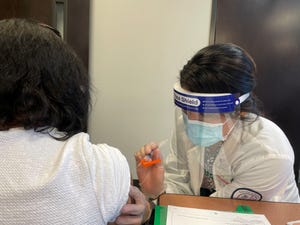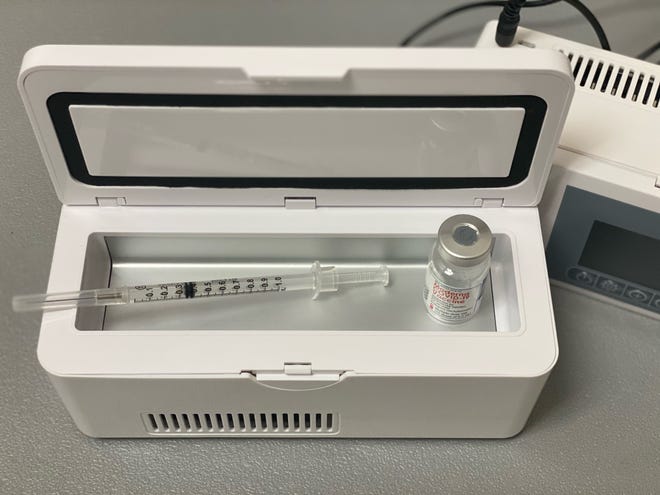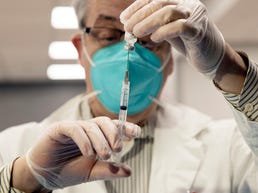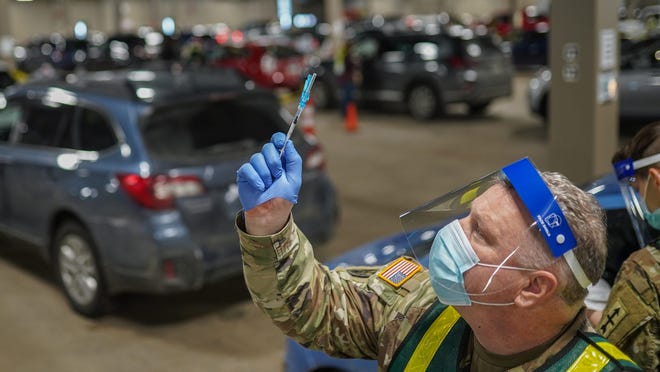experts say it’s always better to use leftover shots
When the COVID-19 vaccine rollout started, there appeared no good solutions for what to do with leftover doses. Vaccinators had been punished for giving shots in violation of precedence lists, whereas fearful clinics had been condemned for throwing doses away.
“Early on, the question was, ‘Is the absolute red line that you don’t throw a dose away? Or is the red line that you don’t give it to the wrong person?'” mentioned Dr. Matthew Zahn, medical director of the division of epidemiology for Orange County in California.
Federal tips existed however weren’t broadly emphasised. The Centers for Disease Control and Prevention’s Advisory Committee on Immunization Practices issued guidance urging “a flexible approach” to the vaccine, particularly when it was at risk of going unused.
Former Surgeon General Jerome Adams tweeted out if it was a case of selecting between losing vaccine or shifting down the precedence teams, the proper motion was to put vaccine in arms.
States nonetheless, did not persistently embrace or talk that to the vaccinators of their space, mentioned Dr. Kelly Moore, deputy director of the non-profit Immunization Action Coalition.
In some instances, directors appeared to fear an excessive amount of about optics and what would possibly seem to be inequities or favoritism when vaccine was in extraordinarily quick provide, mentioned Zahn.
Ten weeks into the U.S. vaccination effort, most hospitals, clinics and vaccination facilities now have protocols and methods in place to be sure that each final dose will get used.
“The No. 1 rule is vaccine cannot go to waste,” mentioned Zahn, a fellow with the Infectious Diseases Society of America. “Have a reasonable plan to try in good faith to reach the most eligible people, but don’t waste vaccine!”
Some have embraced that strategy from the start.
“We’ve always taken the stance that every dose is a life, so we’ve never thrown a dose away,” mentioned Alan Harris, the Emergency Manager of Seminole County in Florida.
Just as a result of it’s the precise factor to do doesn’t suggest it straightforward. Making positive each final dose is used requires legwork, mentioned Harris.
Every Tuesday and Friday his workers name the 100 or so nursing properties and assisted dwelling services within the county to discover out if they’ve new residents or workers who want to be vaccinated.
They compile a listing, after which, if there are doses left over from a vaccination clinic, workers members begin making calls.
“When they get that phone call, it’s delight on the other side of the phone,” Harris mentioned.
Vaccine supply controversies
The strategyis a stark distinction to cases the place vaccinators have been censured for giving leftover doses earlier than they went unhealthy to whoever they may discover.
One infamous case concerned Dr. Hasan Gokal in Houston. He was accused of stealing a vial of vaccine from the Harris County Public Health District on Dec. 29 as a result of he gave unused doses that may have gone to waste to family and friends.
He filed paperwork accounting for what he had carried out and was promptly fired and charged with theft. The prices had been later dismissed.
New York Gov. Andrew Cuomo initially threatened well being care suppliers with a $1 million high quality and lack of their licenses in the event that they vaccinated somebody who was not eligible. That was walked again following reviews of clinics throwing away doses relatively than giving them to individuals who may not match the eligibility profile.
Massachusetts is up entrance about “vaccine wastage,” as it’s referred to as. It makes a chart available online exhibiting tossed COVID-19 vaccine, which in nearly all instances was discarded due to storage or supply issues that allow doses get too heat for too lengthy.
The state’s vaccine allocation guidance particularly requires all vaccine to beused, even when it means shifting down the eligibility record.
“In the rare instance where you have COVID-19 vaccine that will expire and you have no one in the current priority groups to be vaccinated, you can use your clinical judgment to administer the vaccine to a person in another priority group,” it says.
While the difficulty will get a variety of consideration, total vaccine waste seems to be very low, mentioned Dr. Marcus Plescia, chief medical officer for the Association of State and Territorial Health Officials. While there’s no precise information, anecdotally he’snot heard a lot concern about it.
“Most clinical systems are experienced in doing this, they have standards of practice in place to organize how much vaccine they’re going to need for a given clinic,” he mentioned.
That’s the case in Nashville, Tennessee, the place Siloam Health has labored to be sure that no doses go unused.

“We try to schedule vaccination patients in groups of 10, because there are 10 doses in a vial” of the Moderna vaccine, mentioned Dr. Morgan Wills, CEO of the low-income well being community.
Vaccination clinics are scheduled within the morning, so if there’s any additional vaccine as a result of somebody didn’t present up it may be supplied to afternoon clinic sufferers.
They’ve additionally created a listing of all of the community’s sufferers by age to allow them to name and ask if somebody can are available straight away if there are extras.
“We didn’t have somebody dedicated to that beforehand, so we had to allocate a staffer,” Willis mentioned. “Thankfully, we have a very detail-oriented member of our team who’s lending a hand.”
Requirements boost challenge
COVID-19 vaccine is problematic not only because it’s in short supply but because of its exacting storage requirements.
The Pfizer vaccine is shipped frozen in vials that contain up to six doses. To be used, the vial must first be thawed and then mixed with a saline solution. Once mixed, it can be held at room temperature, but if it’s not used within six hours it must be discarded.
The Moderna vaccine also is shipped frozen, in 10-dose vials. It is brought to room temperature, the rubber cap is punctured and vaccine is drawn into a syringe for injection. Once the top has been punctured, the rest of the vial must be used within six hours.
At many COVID-19 vaccination sites, a pharmacist fills syringes with vaccine, which are then taken to the health care professionals doing the vaccination.
“As we get closer to the end of the day, we do fewer syringes to decrease the possibility we’ll have any leftover. At the very last half hour we only fill them as people come in,” said Seminole County’s Harris.
The county never has more than five doses of Pfizer (sometimes it’s possible to get six doses out of a vial) or nine doses of Moderna vaccine at the end of a clinic. Generally, it’s no more than two or three.

Whatever is left is put in small battery-powered refrigerators used to store insulin, about the size of two stacked boxes of spaghetti.These are driven by health care providers to the assisted living facility where someone is waiting.
The important message for vaccinators is that vaccine is precious and should never go to waste, said Dr. Amesh Adalja, a senior scholar, Johns Hopkins Center for Health Security.
That’s especially important in inclement weather when people might not make it to their vaccination appointments
“Maybe you order a pizza and you vaccinate the pizza delivery person,” he mentioned. “You need to have backup plan after backup plan.”





